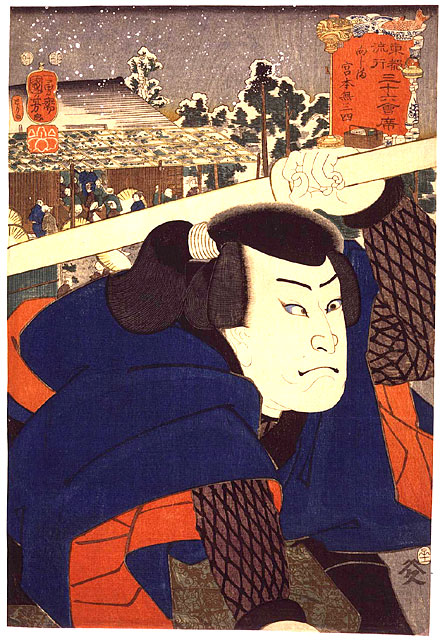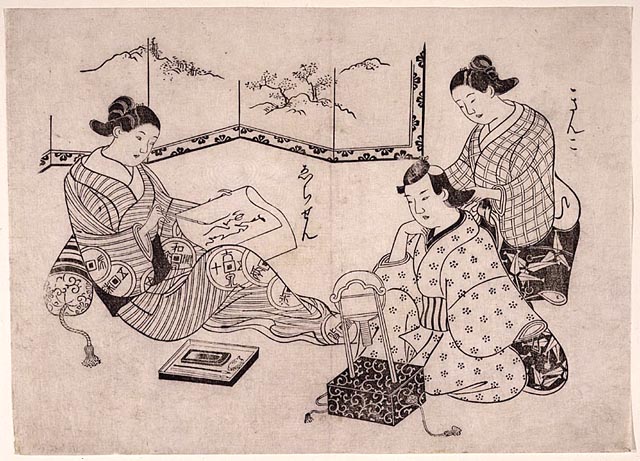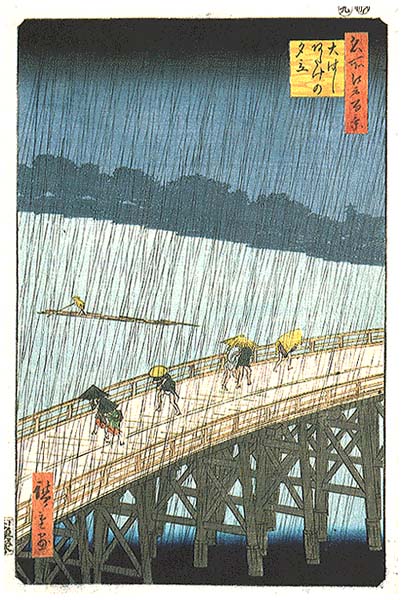
The world in which ukiyo-e
was born was dominated by the warlord government of the shogunate.
The Tokugawa implemented a social system of shinokosho, which stratified
society into four recognized classes of people in the following descending
order: warriors, farmers, artisans, and merchants. Each strata of
the shinokosho provided a service or product to society except the
merchant class (chonin) who created nothing and lived parasitically
off of the exchange of goods (Kita 28).
Chonin controlled a large
portion of wealth but were denied political power and legitimacy.
Considered oppressed due to numerous laws and restrictions, the government
of the Tokugawa realized the need to provide a “safety valve” to release
the resentment built amongst the chonin in such an obstructed society.
This safety valve would become known as the floating world (ukiyo-e)
which included the Kabuki Theater and Yoshiwara district where laws were
not enforced and the chonin could be free. These attractions
became the center of chonin culture and from this culture the ukiyo-e
print was born (Kita 29). These popular pastimes of the floating world
turned into popular artwork meaning to  capture
the fleeting scenes of a social class and appealing to more facets of the
population than any preceding art. The three main subjects of ukiyo-e
prints are the Kabuki Theater, Yoshiwara district, and landscapes. The
theater and brothel culture served as both an outlet for
chonin
to flaunt their wealth and alleviate frustration with the social order.
At the theatre chonin could patronize actors and fund productions
(Kita 38). Kabuki theatre is a type of Japanese theater comprised
of sixteenth century songs and dances originally performed by women and
men and then later exclusively by men. Lasting for hours the Kabuki
drama is saturated with action, numerous props, and elaborate costuming.
Dress, poses and gestures are highly stylized and the actors’ voices are
trained according to defined systems of modulation. Portraits of famous
actors and elaborate play scenes with props and costumes began to be produced.
These were often done in a close-up fashion and exaggerated facial expressions
(Adams 810). capture
the fleeting scenes of a social class and appealing to more facets of the
population than any preceding art. The three main subjects of ukiyo-e
prints are the Kabuki Theater, Yoshiwara district, and landscapes. The
theater and brothel culture served as both an outlet for
chonin
to flaunt their wealth and alleviate frustration with the social order.
At the theatre chonin could patronize actors and fund productions
(Kita 38). Kabuki theatre is a type of Japanese theater comprised
of sixteenth century songs and dances originally performed by women and
men and then later exclusively by men. Lasting for hours the Kabuki
drama is saturated with action, numerous props, and elaborate costuming.
Dress, poses and gestures are highly stylized and the actors’ voices are
trained according to defined systems of modulation. Portraits of famous
actors and elaborate play scenes with props and costumes began to be produced.
These were often done in a close-up fashion and exaggerated facial expressions
(Adams 810).
In the Yoshiwara district, wealth
could purchase female entertainment from the finest (oiran) to the
lowest courtesans (teppo) and gave chonin an opportunity
to act in the role of the aristocrat, quoting literature and commissioning
art (Kita 39). These courteasan beauties took center stage in the
prints and set the standards for popular trends with fashion and elegant
poses. Their images reflect an expression of mood and personality
shown in facial expression. Both of these images were highly idealized
and fantasized to meet the current aesthetic. Common scenes were
also captured such as domestic activities, festivals, even laundry (Kita
53).
In the second quarter of the nineteenth
century landscapes, which were once considered mere background, began serving
in the foreground to illustrate man’s place with nature. In
the traditional Japanese view humans do not control or attempt to dominate
nature, but instead attempt to live in harmony with all other creatures
and natural forces of the earth. This is especially exhibited by
Katsushika Hokusai (1760-1849) one of the most famous landscape artists
of the 19th century whose Great Wave of Kanagawa is most recognizable.
There is a dramatic feel in the rise of the wave so close to the picture
plane towering above the men in boats who seem to bow to the wave (Addiss103-104).
This wave represents a temporary peak, which will fall in an instant but
Fuji in the center of the background remains, which is often linked, to
Japan’s sense of nationhood and patriotism (Baird 34) The other  famous
landscape artist Utagawa Hiroshige (1797-1858) produced a series of travel
prints featuring the road between Edo and Kyoto, the Tokaido. As
more people began traveling this road from all walks of life, prints were
created for them to serve as souvenirs, records of travel, or even postcards.
These memories represented the spirit of Japan from the point of view of
the lower classes throughout seasons, weather, and times of day (Addiss
103-109). A Buddhist dissection of the term ukiyo-e reveals
two seemingly incompatible definitions: the floating world and the sorrowful
world. The floating world of pleasures does not appear to be sorrowful
at all however in a strictly Buddhist sense, a connection is discovered
through confronting the outlook on death. For most humans, there is fear
in the mystery of death and afterlife and one instinctually clings to the
material world. There is no afterlife in Buddhist teachings; Buddha
warns against clinging to life because of its temporary qualities.
Only sorrow results in humans’ futile decision to attempts to maintain
what naturally disappears. Thus the connection of the floating world
where one turns to the present transient pleasures of flesh and material
are by definition also a sorrowful world (Kita 56). This ukiyo-e
world is symbolically marked by the cherry blossom whose beauty may only
last a few days before being destroyed by rain or wind but are admired
for their impermanence and appreciated for their beauty. Incidentally
the type of wood traditionally used to carve woodblock is cherry (Addiss
99). famous
landscape artist Utagawa Hiroshige (1797-1858) produced a series of travel
prints featuring the road between Edo and Kyoto, the Tokaido. As
more people began traveling this road from all walks of life, prints were
created for them to serve as souvenirs, records of travel, or even postcards.
These memories represented the spirit of Japan from the point of view of
the lower classes throughout seasons, weather, and times of day (Addiss
103-109). A Buddhist dissection of the term ukiyo-e reveals
two seemingly incompatible definitions: the floating world and the sorrowful
world. The floating world of pleasures does not appear to be sorrowful
at all however in a strictly Buddhist sense, a connection is discovered
through confronting the outlook on death. For most humans, there is fear
in the mystery of death and afterlife and one instinctually clings to the
material world. There is no afterlife in Buddhist teachings; Buddha
warns against clinging to life because of its temporary qualities.
Only sorrow results in humans’ futile decision to attempts to maintain
what naturally disappears. Thus the connection of the floating world
where one turns to the present transient pleasures of flesh and material
are by definition also a sorrowful world (Kita 56). This ukiyo-e
world is symbolically marked by the cherry blossom whose beauty may only
last a few days before being destroyed by rain or wind but are admired
for their impermanence and appreciated for their beauty. Incidentally
the type of wood traditionally used to carve woodblock is cherry (Addiss
99).
|
 Evidence
of human desire to leave a mark upon the material world has existed as
art since the discovery of cave paintings created 35,000 years ago.
Techniques and style vary from culture to culture, but art acts as a keyhole
allowing glimpses into aspects of the contemporary society.
Social, political, and economic factors influence the production and content
of artwork throughout periods in history. Ancient Japan employed pottery
as an early and practical art form but as society became increasingly sophisticated
so too did its reflection in artwork. One of the most renowned types
of art produced in Japan is the woodblock print, which reached its Golden
Age in the Edo Period of 1600-1868 with the production of ukiyo-e,
pictures of the floating world. The term ukiyo can be defined literally
as floating world, a Buddhist concept referring to the transient pleasures
of material existence and e, the everyday pictures captured in printed
woodblock form (Addiss 95). This paper will examine the history of
the woodblock technique, the evolution and content of the ukiyo-e,
and the internal and external impact of the ukiyo-e movement.
Evidence
of human desire to leave a mark upon the material world has existed as
art since the discovery of cave paintings created 35,000 years ago.
Techniques and style vary from culture to culture, but art acts as a keyhole
allowing glimpses into aspects of the contemporary society.
Social, political, and economic factors influence the production and content
of artwork throughout periods in history. Ancient Japan employed pottery
as an early and practical art form but as society became increasingly sophisticated
so too did its reflection in artwork. One of the most renowned types
of art produced in Japan is the woodblock print, which reached its Golden
Age in the Edo Period of 1600-1868 with the production of ukiyo-e,
pictures of the floating world. The term ukiyo can be defined literally
as floating world, a Buddhist concept referring to the transient pleasures
of material existence and e, the everyday pictures captured in printed
woodblock form (Addiss 95). This paper will examine the history of
the woodblock technique, the evolution and content of the ukiyo-e,
and the internal and external impact of the ukiyo-e movement.
 capture
the fleeting scenes of a social class and appealing to more facets of the
population than any preceding art. The three main subjects of ukiyo-e
prints are the Kabuki Theater, Yoshiwara district, and landscapes. The
theater and brothel culture served as both an outlet for
chonin
to flaunt their wealth and alleviate frustration with the social order.
At the theatre chonin could patronize actors and fund productions
(Kita 38). Kabuki theatre is a type of Japanese theater comprised
of sixteenth century songs and dances originally performed by women and
men and then later exclusively by men. Lasting for hours the Kabuki
drama is saturated with action, numerous props, and elaborate costuming.
Dress, poses and gestures are highly stylized and the actors’ voices are
trained according to defined systems of modulation. Portraits of famous
actors and elaborate play scenes with props and costumes began to be produced.
These were often done in a close-up fashion and exaggerated facial expressions
(Adams 810).
capture
the fleeting scenes of a social class and appealing to more facets of the
population than any preceding art. The three main subjects of ukiyo-e
prints are the Kabuki Theater, Yoshiwara district, and landscapes. The
theater and brothel culture served as both an outlet for
chonin
to flaunt their wealth and alleviate frustration with the social order.
At the theatre chonin could patronize actors and fund productions
(Kita 38). Kabuki theatre is a type of Japanese theater comprised
of sixteenth century songs and dances originally performed by women and
men and then later exclusively by men. Lasting for hours the Kabuki
drama is saturated with action, numerous props, and elaborate costuming.
Dress, poses and gestures are highly stylized and the actors’ voices are
trained according to defined systems of modulation. Portraits of famous
actors and elaborate play scenes with props and costumes began to be produced.
These were often done in a close-up fashion and exaggerated facial expressions
(Adams 810).
 Stylistically
speaking the ukiyo-e print possessed distinct Asian qualities that were
adopted and adapted by Western painters. Ukiyo-e prints were distinguished
by oversized monumental figures filling the entire composition to really
bring the view into the picture. Gestures and poses were highly stylized
with elongated features distinguished by delicate black contour lines.
The perspective often times offers multiple viewpoints at once and disregards
traditional three dimensional space as depicted in Western art for flat
one-dimensional work. The strong diagonals greatly influenced the
work of Van Gogh as is seen in Japonaiserie: Bridge in the Rain 1887
after Utagawa Hiroshige’s Sudden Shower at Ohashi Bridge at Ataka
from the series One Hundred Views of Edo of 1857 (Adams 846).
Here one sees the influence also of the West on East with a linear perspective
of the one-point perspective. Filled with bold color woodblocks contain
spectacular costuming with amazing attention to detail of patterns in which
the Impressionist Mary Cassatt took an interest (Adams 822).
Stylistically
speaking the ukiyo-e print possessed distinct Asian qualities that were
adopted and adapted by Western painters. Ukiyo-e prints were distinguished
by oversized monumental figures filling the entire composition to really
bring the view into the picture. Gestures and poses were highly stylized
with elongated features distinguished by delicate black contour lines.
The perspective often times offers multiple viewpoints at once and disregards
traditional three dimensional space as depicted in Western art for flat
one-dimensional work. The strong diagonals greatly influenced the
work of Van Gogh as is seen in Japonaiserie: Bridge in the Rain 1887
after Utagawa Hiroshige’s Sudden Shower at Ohashi Bridge at Ataka
from the series One Hundred Views of Edo of 1857 (Adams 846).
Here one sees the influence also of the West on East with a linear perspective
of the one-point perspective. Filled with bold color woodblocks contain
spectacular costuming with amazing attention to detail of patterns in which
the Impressionist Mary Cassatt took an interest (Adams 822).
 The
Impressionist movement of 1860-1920 was centered in Paris and was the antithesis
to the preceding period of Realism. Impressionists preferred to exchange
their ideas in Bohemian surroundings of cafes and bars because their movement
was initially seen as a challenge and was rejected by the Academy.
So too was the ukiyo-e print a first viewed as an illegitmated trend
separate from the sophisticated upper class. Being the first Japanese
art form to transcend social status ukiyo-e became popular amongst
people despite education or income level. Impressionist works
were consistent with the
ukiyo-e, depiction of genre subjects most
especially scenes of leisure activities, entertainment, and landscapes.
Impressionists took interest in the effects light had in varying weather
conditions, seasons, and time of day on subject matter as seen in the Hokusai’s
landscape series Thirty Six Views of Mt. Fuji where scenes in different
or similar views of the same place (Mt. Fuji) at different times of the
day and different seasons. Both movements’ compositions are chopped off
and asymmetrical which allows the viewer to feel as if included in the
image by catching a scene in motion similar to the photograph snapshot.
Impressionists began experimenting with a focus on flat color and patterns
and different poses inspired by woodblock patterned fabrics (Adams 805,
810-814).
The
Impressionist movement of 1860-1920 was centered in Paris and was the antithesis
to the preceding period of Realism. Impressionists preferred to exchange
their ideas in Bohemian surroundings of cafes and bars because their movement
was initially seen as a challenge and was rejected by the Academy.
So too was the ukiyo-e print a first viewed as an illegitmated trend
separate from the sophisticated upper class. Being the first Japanese
art form to transcend social status ukiyo-e became popular amongst
people despite education or income level. Impressionist works
were consistent with the
ukiyo-e, depiction of genre subjects most
especially scenes of leisure activities, entertainment, and landscapes.
Impressionists took interest in the effects light had in varying weather
conditions, seasons, and time of day on subject matter as seen in the Hokusai’s
landscape series Thirty Six Views of Mt. Fuji where scenes in different
or similar views of the same place (Mt. Fuji) at different times of the
day and different seasons. Both movements’ compositions are chopped off
and asymmetrical which allows the viewer to feel as if included in the
image by catching a scene in motion similar to the photograph snapshot.
Impressionists began experimenting with a focus on flat color and patterns
and different poses inspired by woodblock patterned fabrics (Adams 805,
810-814).